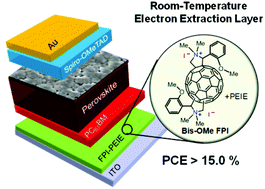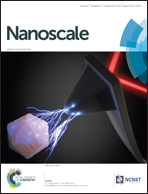Room-temperature, solution-processable organic electron extraction layer for high-performance planar heterojunction perovskite solar cells†
Abstract
In this work, we describe a room-temperature, solution-processable organic electron extraction layer (EEL) for high-performance planar heterojunction perovskite solar cells (PHJ PVSCs). This EEL is composed of a bilayered fulleropyrrolidinium iodide (FPI)-polyethyleneimine (PEIE) and PC61BM, which yields a promising power conversion efficiency (PCE) of 15.7% with insignificant hysteresis. We reveal that PC61BM can serve as a surface modifier of FPI-PEIE to simultaneously facilitate the crystallization of perovskite and the charge extraction at FPI-PEIE/CH3NH3PbI3 interface. Furthermore, the FPI-PEIE can also tune the work function of ITO and dope PC61BM to promote the efficient electron transport between ITO and PC61BM. Based on the advantages of room-temperature processability and decent electrical property of FPI-PEIE/PC61BM EEL, a high-performance flexible PVSC with a PCE ∼10% is eventually demonstrated. This study shows the potential of low-temperature processed organic EEL to replace transition metal oxide-based interlayers for highly printing compatible PVSCs with high-performance.


 Please wait while we load your content...
Please wait while we load your content...